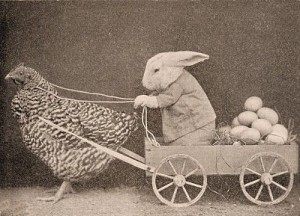 Ever wonder what eggs, the Easter bunny and the equinox have to do with Easter? Me too!
Ever wonder what eggs, the Easter bunny and the equinox have to do with Easter? Me too!
Turns out this unlikely list of symbols and names is more like a natural blending of traditions and one that Pagans jest the Christians hijacked from them. See Christians celebrate Easter and the Pagans celebrate Ostara…hmm they sound oddly alike?
Like most modern day traditions in North America we forget the original meaning, turning them into consumer driven excuses to consume chocolate and sugar, and purchase pastel clothing.
The good news is we haven’t completely abandoned all custom and symbolism of this celebration, and by taking the time to understand why our ancestors felt this time of year was special we can begin to relate. Turns out we have been celebrating Ostara and Easter and we probably didn’t even know it!
Easter is the celebration of Christ’s resurrection. While that is the Christian meaning of Easter there is a fusion of many ancient cultures, traditions and practices mostlyearly Pagan and Christian that are included in this celebration. Eggs (painted and chocolate), spring flowers(daffodils, tulips, lillies), rabbits, chocolate and Easter bonnets all come to mind, as does Church Easter Sunday services.

Ostara (pronounced O-starr-ah) is a mythological German Goddess of spring and fertility. Her name is derived from the Germanic Eostre (meaning east). Perhaps you are starting to see the relationship to the word Easter?! This celebration takes place during March’s Vernal Equinox. It is the ancient pagan celebration of balance between dark and light, masculine and feminine. The rejuvenation and shedding of winter’s cold dark days. This is a time to plant gardens, be in nature and celebrate the spring arrival of plant and animal new births.
In Celtic tradition, the hare became a symbol for the moon and fertility during spring equinox when nature’s fertility gets ramped up! The hare (a nocturnal animal most of the year) comes out to play (so to speak) in March (mating season). As a result, there is an abundance of bunnies at this fertile time of year.
The egg is a symbol of potential and new life. It reminds us of the rebirth and fertility of nature, the creation we see growing around us at this time of year. Eggs represent “fertility” but why only the spring? Turns out that chickens do not naturally lay eggs in the winter! They begin to lay eggs when the days become longer and March/April are peak laying times. You can imagine their increased value for those coming off a winter diet of meager protein and no eggs. It is worth mentioning that Lent (the week before Easter, eating eggs, meat and dairy are forbidden). Gifting eggs at this time of year was a common practice for the ancients as was giving it in a basket. It’s not hard to imagine the natural evolution of coloring eggs to enhance their appearance for gift giving.

The Goddess Ostara has both the Moon (equinox) and Hare (fertility) as her sacred symbols, this completely makes sense, I love how this all comes together! Now I understand how the Easter Bunny ties in with colored eggs on Easter morning the day we celebrate Christ’s resurrection. What an amazing fusion of cultures we celebrate!
I do love Easter, and probably more so now that I understand the ritual and symbolism.
Interesting Fact #1
- Did you know that you can balance an egg on its end during the exact time of the Equinox! Discover the exact time in your area and a few minutes before, find a level spot (outdoors?) take your raw egg (wide end down) and balance it. It will stay for a few minutes prior and post the equinox time. Let me know how it works!
Interesting Fact #2
- Equinox is Latin for: equi (equal) nox (night) Equal Night
Interesting Fact #3
- Ostara, Goddess of Fertility has the fertility hormone Estrogen named after her!

